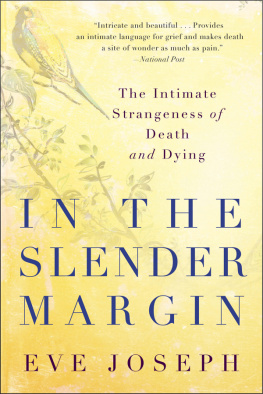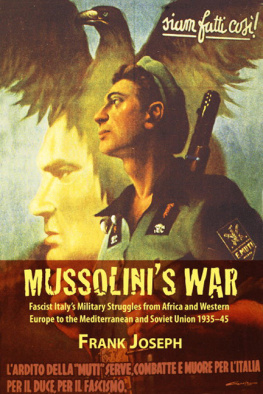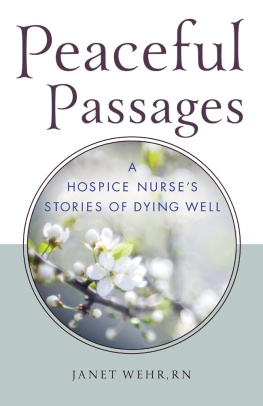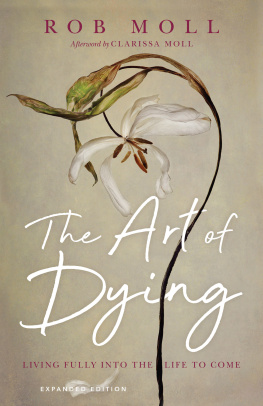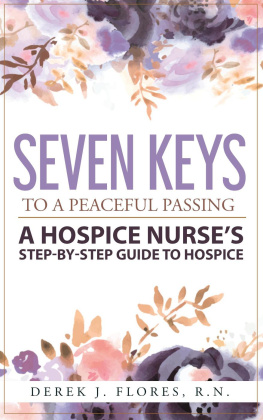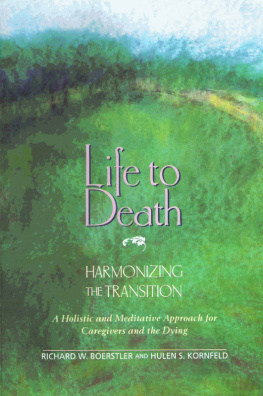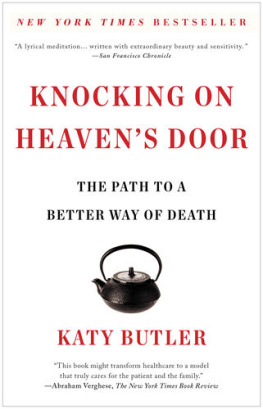Copyright 2014 by Eve Joseph
All rights reserved. No part of this book may be reproduced in any manner without the express written consent of the publisher, except in the case of brief excerpts in critical reviews or articles. All inquiries should be addressed to Arcade Publishing, 307 West 36th Street, 11th Floor, New York, NY 10018.
First US Edition 2016
Arcade Publishing books may be purchased in bulk at special discounts for sales promotion, corporate gifts, fund-raising, or educational purposes. Special editions can also be created to specifications. For details, contact the Special Sales Department, Arcade Publishing, 307 West 36th Street, 11th Floor, New York, NY 10018 or .
Arcade Publishing is a registered trademark of Skyhorse Publishing, Inc., a Delaware corporation.
Visit our website at www.arcadepub.com.
10 9 8 7 6 5 4 3 2 1
Library of Congress Cataloging-in-Publication Data
Joseph, Eve, 1953author.
In the slender margin : the intimate strangeness of death and dying / Eve Joseph. First US Edition.
pages cm
Includes bibliographical references and index.
ISBN 978-1-62872-583-4 (hardback); ISBN 978-1-62872-627-5 (E-book)
1. Death. 2. Loss (Psychology) 3. Joseph, Eve, 1953Anecdotes. I. Title.
BD444.J58 2016
155.937092dc23
2015027969
Cover design by Georgia Morrissey
Cover illustration: Shutterstock
Printed in the United States of America
For Ian
On the night we die a thousand others go with us.
D. J. Enright, The Oxford Book of Death
Contents
THE BASEMENT
The sun will die in its sleep beneath a bridge and trailing westward like a winding-sheet listen, my dearhow softly Night arrives.
CHARLES BAUDELAIRE , Meditation
A Forbidden Room
I had just turned twelve when my brother was killed in a car accident. In 1965, the year Allen Ginsberg coined the term flower power and Malcolm X was shot dead inside Harlems Audubon Ballroom, the year T. S. Eliot died and Bob Dylans Like a Rolling Stone was on its way to becoming a new anthem, death was regarded as a taboo subject. Not a lot was known about what to do with a kid whose brother had suddenly died on the other side of the country.
It was late evening when the call came. The blinds were drawn against the dark of January, and the dog lay sleeping in front of the fireplace. The phone, ringing at the wrong time, sounded loud, as if ringing in an empty house. My mothers face changed that night. One minute she was reading on the couch, the right side of her face bathed in lamplight, the left in shadow; the next, the phone was in her hand, only she wasnt talking into it, she was holding it away from her face and her words were not making sense. I sat sideways on a chair across from her, dangling my legs. My feet didnt quite reach the floor, and when she screamed I swung my legs faster as if I were on a swing. That night my mother rocked in a chair and I slept on the floor, curled at her feet. In his diary, Edvard Munch wrote that he was inspired to paint The Scream when he saw the sky turn blood red while walking along a path with two friends at sunset: I paused, feeling exhausted, and leaned on the fencethere was blood and tongues of fire above the blue-black fjord and the cityI sensed an infinite scream passing through nature.
I grew up in a house of ghosts. My brothers death followed the deaths of my mothers mother, her father, and her brother in the war. When a bomb hit my grandmothers house in London, she was killed by falling debris just as she reached for the gin and tonic my mother was passing to her. Years after the war, a shell fragment pushed its way through my mothers eyebrow; the entry wounds were invisible but the evidence was compelling. Her stories were like that. It took the rescuers thirty hours to dig through the rubble. Emerging out of the dust like coal miners, they lifted her back into the light of an unrecognizable city. She never learned where they took her mothers body. None of my deaths, she later told me, have markers.
My mothers grief over my brothers death reverberated through her nerve endings into the night sky. Inseparable from the infinite, it howled along a stretch of highway thousands of miles away and settled in the bones of her face like Dylans ghost of electricity . It entered herand me, toolike a permanent vibration.
By the 1960s it was generally believed that children needed to be protected and shielded from loss, but this was not always the case. In the mid-1800s, children were given death kits, complete with miniature coffins and mourning clothes to familiarize them with death. For girls in particular, dressing their dolls in black and laying them out was a kind of rehearsal to prepare them to participate in the death rituals of adulthood. Until the twentieth century, the preparation of the bodies of the dead occurred mostly in peoples homes. In 1909, D. H. Lawrence laid the body of a miner out on the floor in his short story Odour of Chrysanthemums. Neither the wife nor the mother could forget, as they bathed him, that it was death they worked with: He was heavy and inert, it was hard work to clothe him. Death was an integrated part of life. People died at home rather than in institutions, infant death rates were high, and life expectancy was much shorter. It wasnt until the 1920s, with breakthroughs in medical care and the rise of the funeral industry, that death and the subject of dying began to retreat into the shadows.
After the Second World War, the influx of women into the labor force and the migration from rural to urban centers for work made it increasingly difficult to care for the sick and elderly at home. More and more, the old were sent to nursing homes. With medical advances came the belief that death could be postponed almost indefinitely and was a battle to be fought and won at all costs. What couldnt be fixed was removed from view, and along with what was removed from view, our memories of what to do and how to think about death began to fade as well. In the home I grew up in, death was a well-kept secret; for many years it felt as if I were standing on tiptoes, peeking into a forbidden room.
I spent the time between the phone call and my brothers burial playing with my collection of small plastic horses in the basement. The poet Dorothy Livesays son, Peter, was attending university and living with us at the time, and it fell to him to stay with me while the adults upstairs struggled over funeral arrangements. I had Pintos, Mustangs, Appaloosas, and coal-black Arabians and at one point, when the adults were agonizing over burial or cremation, I must have headed out on the dappled Paint and made a beeline for the badlands. All of the horses following me, heading to a sheltered valley to set up camp and sleep beneath a million stars that sparkled like five-pointed sheriffs badges.
It was raining the day Ian was buried. Memory is often deceptive: in my mind I was downstairs for days on end, but of course, this cant be true. More bewildered than sad, I did not know that grief had taken up permanent residence in our house on the corner of Sixth Street. I did not understand that I was being shaped not so much by grief but by the silence surrounding it. When I surfaced, out of the basement, the funeral was over and everyone had gone home. I watched my mother gather armfuls of lilies and throw them in the trash can.
I see now that our first experiences with loss shape us in ways we dont understand at the time. The death of Sylvia Plaths father when she was eight carved out a small space inside her where the idea of suicide could burrow in. In The Year of Magical Thinking, Joan Didion writes that, with death, something inside us is dislodged, calved like a piece of sheer blue ice from a glacier. C. S. Lewis suggests that with death there are no lights on in the windows of the house, and we wonder, along with him, if it was ever inhabited.

